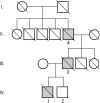Familial prion disease in a Hungarian family with a novel 144-base pair insertion in the prion protein gene
- PMID: 17308293
- PMCID: PMC2117636
- DOI: 10.1136/jnnp.2006.104372
Familial prion disease in a Hungarian family with a novel 144-base pair insertion in the prion protein gene
Abstract
About 15% of human prion diseases are inherited, and are associated with point or insertional mutations of the prion protein gene (PRNP). Four families with six octapeptide repeat insertions (OPRI) in the PRNP gene have been described in the literature so far. Here we report two cases in a Hungarian family with a new six OPRI (R1R2R2R3R2R3gR3R2R2R3R4) in the PRNP gene. The clinical features (progressive ataxia, dementia and anosmia), the age of onset and the duration of disease were almost identical. In addition to the cerebellar and parahippocampal pathological changes already described, we also found deposits of pathological prion protein in the olfactory system.
Conflict of interest statement
Competing interests: None declared.
Similar articles
-
A Novel Eight Octapeptide Repeat Insertion in PRNP Causing Prion Disease in a Danish Family.J Neuropathol Exp Neurol. 2019 Jul 1;78(7):595-604. doi: 10.1093/jnen/nlz037. J Neuropathol Exp Neurol. 2019. PMID: 31107536
-
Genotype-phenotype analysis in inherited prion disease with eight octapeptide repeat insertional mutation.Prion. 2013 Nov-Dec;7(6):501-10. doi: 10.4161/pri.27260. Epub 2013 Nov 25. Prion. 2013. PMID: 24275071 Free PMC article.
-
Inherited prion disease with 5-OPRI: phenotype modification by repeat length and codon 129.Neurology. 2007 Aug 21;69(8):730-8. doi: 10.1212/01.wnl.0000267642.41594.9d. Neurology. 2007. PMID: 17709704
-
A novel seven-octapeptide repeat insertion in the prion protein gene (PRNP) in a Dutch pedigree with Gerstmann-Sträussler-Scheinker disease phenotype: comparison with similar cases from the literature.Acta Neuropathol. 2011 Jan;121(1):59-68. doi: 10.1007/s00401-010-0656-3. Epub 2010 Mar 3. Acta Neuropathol. 2011. PMID: 20198483 Free PMC article. Review.
-
Genetic prion disease: Experience of a rapidly progressive dementia center in the United States and a review of the literature.Am J Med Genet B Neuropsychiatr Genet. 2017 Jan;174(1):36-69. doi: 10.1002/ajmg.b.32505. Am J Med Genet B Neuropsychiatr Genet. 2017. PMID: 27943639 Free PMC article. Review.
Cited by
-
Early onset prion disease from octarepeat expansion correlates with copper binding properties.PLoS Pathog. 2009 Apr;5(4):e1000390. doi: 10.1371/journal.ppat.1000390. Epub 2009 Apr 17. PLoS Pathog. 2009. PMID: 19381258 Free PMC article.
-
Filamentous white matter prion protein deposition is a distinctive feature of multiple inherited prion diseases.Acta Neuropathol Commun. 2013 May 9;1(1):8. doi: 10.1186/2051-5960-1-8. Acta Neuropathol Commun. 2013. PMID: 24252267 Free PMC article.
-
Protease-sensitive prions with 144-bp insertion mutations.Aging (Albany NY). 2013 Mar;5(3):155-73. doi: 10.18632/aging.100543. Aging (Albany NY). 2013. PMID: 23515139 Free PMC article.
References
-
- Collinge J. Prion diseases of humans and animals: their causes and molecular basis. Annu Rev Neurosci 200124519–550. - PubMed
Publication types
MeSH terms
Substances
Grants and funding
LinkOut - more resources
Full Text Sources


